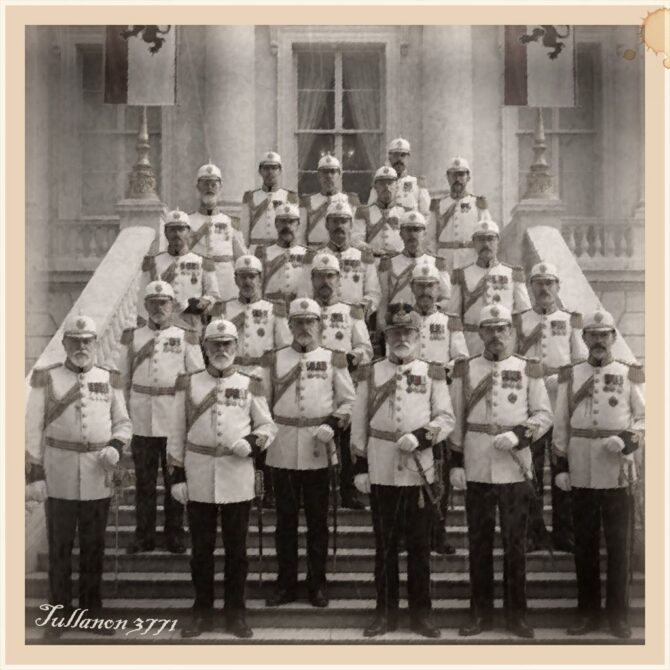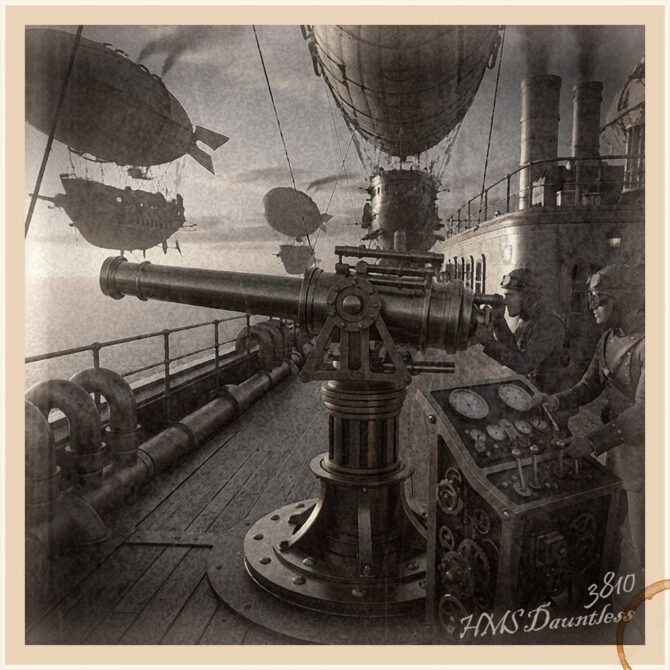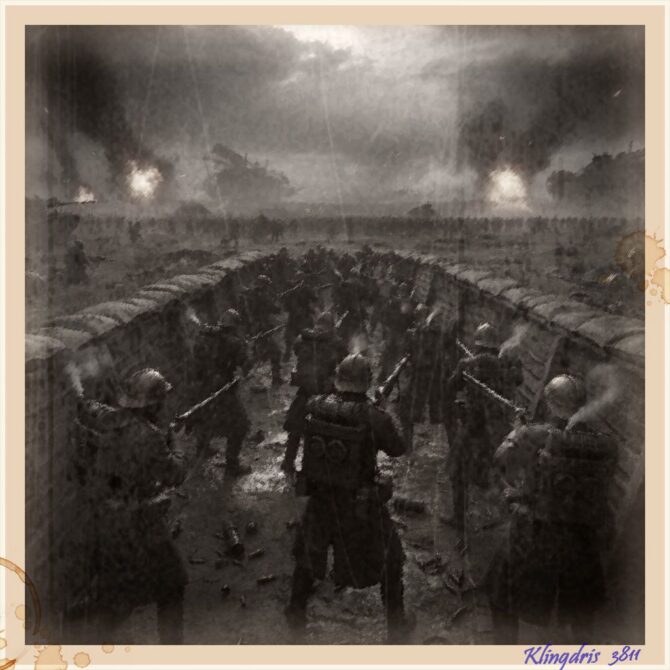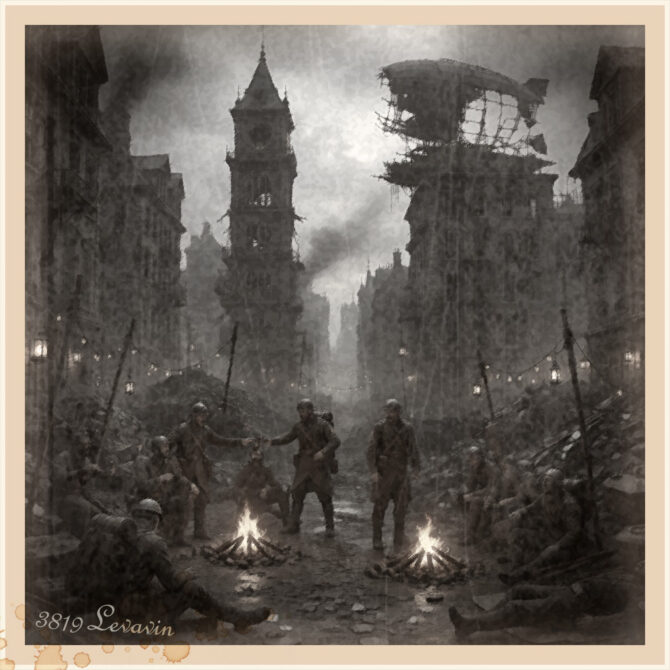
Fifty Years of Steam and Iron
When the unyielding Industrial Revolution irrevocably reshaped the globe and stoked the ravenous ambitions of crowned heads, the continent of Ezirea and its surrounding territories were plunged into a conflict that would forever scar the face of the world. For half a century, stretching from the nascent years of the technological boom to a mere three decades ago, the Kingdom of Fergeria, the Alledian Empire, the Grand Duchy of Cordaina, and the Kingdom of Aclea clashed in an armed struggle known simply as “The Long War.” It was a conflict fueled by steam, iron, and a merciless hunger for dominance, and its hallmark technological ferocity lent it a brutal yet strangely fascinating dimension, culminating in a spectacular, unforeseen Aetheric Breakthrough.

The conflagration ignited almost instantly once the new machinery, birthed from the Industrial Revolution’s fiery crucible, became available to the military arsenals. Seeing in the raw power of steam engines and mechanised weaponry a clear path to the ultimate subjugation of the continent, the rulers of the individual nations hesitated not a moment to unleash this power.
The Alledian Empire, a military titan renowned for its granite discipline and strategic foresight, staked its power on gigantic, steam-powered siege engines—colossal steam tanks whose formidable armour plating was all but impenetrable, alongside mobile rail-cannons capable of leveling entire urban centres. Their doctrine was one of crushing firepower and a slow, methodical advance, a juggernaut’s march.
The Grand Duchy of Cordaina, located in the frigid north, prioritised speed and sheer manoeuvrability. Their strength lay in squadrons of swift, scouting airships and rapid, armoured wheeled vehicles, perfect for lightning-fast raids and flanking manoeuvres against the enemy’s slow flanks. Cordaina also heavily invested in advanced mechanical drones for aerial reconnaissance, the very eyes of their war machine.
The Kingdom of Aclea, Fergeria’s western neighbour, focused on mobile steam-artillery and highly disciplined infantry units equipped with pneumatic weaponry. They became the undisputed masters of positional warfare, employing intricate systems of trenches and mechanised fortifications, turning every line into a formidable, earthbound fortress.
The Kingdom of Fergeria, with Edenlon as its crucial, bustling port, concentrated its innovations on transport and communication, as well as the development of a powerful aerial fleet based on classic steam-powered dirigibles and sophisticated gyrocopters. Their defining advantage quickly became their mobile command centres and a remarkable capacity for swift, airborne troop deployment.

1. The Opening Salvo (Years 1–10)
The Scramble for Resources and Technical Edge
The initial decade of the conflict was primarily a ruthless struggle for coal and iron ore deposits—the very lifeblood of the new war machinery. Battles were savage and merciless, often resulting in staggering losses of men and materiel. During this phase, the critical advantage lay in the sheer speed of technological adaptation. Fergeria, propelled by research from its world-class universities, swiftly outpaced its rivals in the fields of airship design and communications, utilizing experimental Aetheric devices, affording them an unparalleled edge in reconnaissance and the rapid transport of aerial forces.
2. The Continental Quagmire (Years 10–30)
The Vortex Expands
The conflict metastasized rapidly, engulfing the entire continent of Ezirea. Alliances shifted with bewildering speed, like pieces on a constantly moving board, and formerly neutral states were dragged into the fray, often under the looming threat of force. New and terrifying weapons emerged: steam-powered landmines, incapacitating paralytic gases delivered by airships, and even early prototypes of mechanical soldiers—crude but terrifying automata. The high seas were transformed into an arena for battles between heavily armoured steam-battleships and insidious submersible craft. International trade collapsed, and national economies were wholly repurposed for the singular, unyielding goal of war production.
3. The Total Phase (Years 30–45)
A Mechanised Apocalypse
This period marked the most intense and grinding phase of combat. Fronts stabilised into grim, static lines, but their nature was utterly terrifying. Gigantic war machines—flying fortresses, ironclad rail trains, and colossal field excavators—blasted the landscape, leaving behind a scarred terrain, ruined cities, and battlefields choked with the wreckage of shattered machinery. The use of armoured trains and immense, slow-moving steam golems increased, sowing widespread destruction. The health impact of air pollution from soot and industrial dust became a grim, universal reality.
4. The Final Stand (Years 45–50)
The Aetheric Breakthrough and the Stalemate
The last five years were a desperate, total war. Every nation, exhausted but resolute, threw its final resources into the inferno. Vast aerial battles became commonplace spectacles, with enormous steam dirigibles and mechanised flying citadels vying for absolute dominion of the skies. The infantry, clad in rudimentary mechanical exoskeletons and armed with machine guns, fought for every blasted metre of ground, while mechanised engineering corps built and destroyed fortifications at a dizzying pace.

It was in this most desperate act of the war that the savants of the University Quarter in Edenlon—led by Professor Eldrin Thorne and Kava Emelina d’Iglesia—achieved a revolutionary feat: the mastery of aetheric kinetics. The invention of the aetheric stabilizer permitted the creation of the first genuine aether-powered sky-vessels, such as the magnificent ‘Eden’s Ray’. These new craft, far swifter, more agile, and capable of sustained flight without the constant need for refuelling that plagued their steam-driven brethren, granted Fergeria a sudden and potent advantage.
The introduction of the aether-ships, though it came at the eleventh hour, sowed a critical seed of panic and disarray among the enemy ranks. Their ability to execute blindingly fast, precise strikes on distant targets while evading entrenched air defences was a game-changer, utterly unheard of. Yet, even this profound technological leap was insufficient to definitively tilt the scales of victory. The other Great Powers, stunned but not broken, immediately intensified their own research into similar technologies, sparking an accelerated arms race.
Despite the dizzying technological advances and the catastrophic losses, no single side was ever able to achieve a decisive victory. Every new weapon was rapidly countered, and an advantage on one front was instantly nullified on another. The arrival of the Aether, while a revolution in its own right, came too late to deliver the final blow, serving only to deepen the universal sense of exhaustion and futility inherent in this prolonged and bitter war.

After fifty punishing years of war, with national treasuries depleted and morale teetering on the brink of collapse, an armistice was finally signed. Intriguingly, every one of the warring Great Powers promptly declared a resounding victory.
The Alledian Empire asserted that their unyielding mechanised force had ultimately shattered the enemy’s will to resist. The Grand Duchy of Cordaina championed its agility and the success of its special operations in destabilising enemy supply lines. The Kingdom of Aclea boasted of its steadfast defence and its unshakeable endurance against overwhelming force. And the Kingdom of Fergeria, specifically the proud city of Edenlon, lauded its technological genius, pointing to its aerial dominance and the innovation of aetheric propulsion as the key to survival—a dawn that heralded a new age.
Regardless of the rhetoric, the grim reality was that all were utterly spent. The ensuing thirty years have been a period of unprecedented technological and economic flourishing, driven by the very innovations forged in the furnace of wartime necessity. The Aether, harnessed at the close of the conflict, became the potent catalyst for a fresh wave of invention, from flying machines and advanced communication networks to sophisticated automatons. The very machines that were once instruments of mass destruction now build cities, power factories, and enable travel on a scale previously unimaginable. The continent of Ezirea, though still bearing the scars of the Long War, thrives, and its inhabitants, mindful of the terrible price of conflict, strive to build a future where steam, iron, and aether serve progress, not annihilation. Relations between the Great Powers remain tense, yet none possess the appetite to return to the hell of full-scale war.
